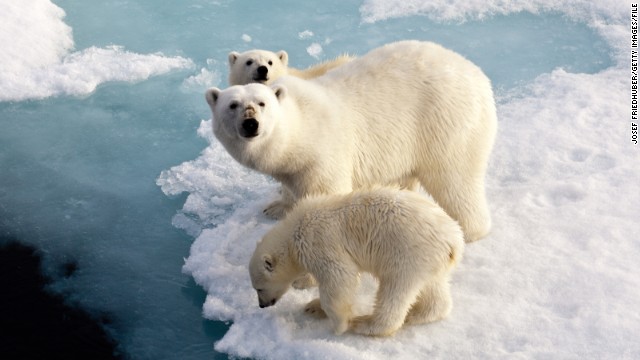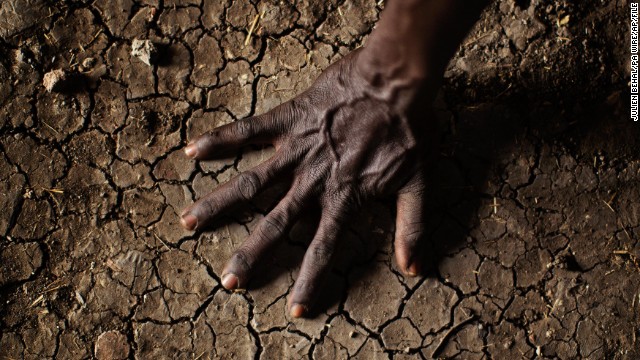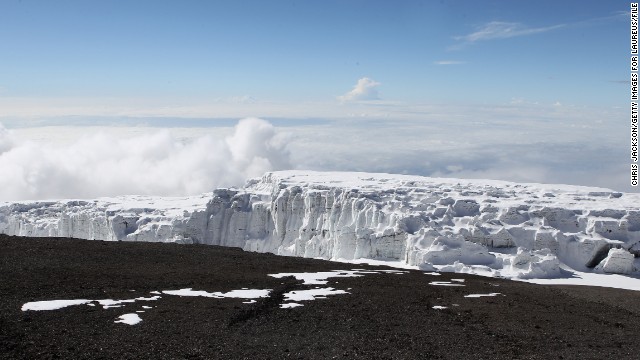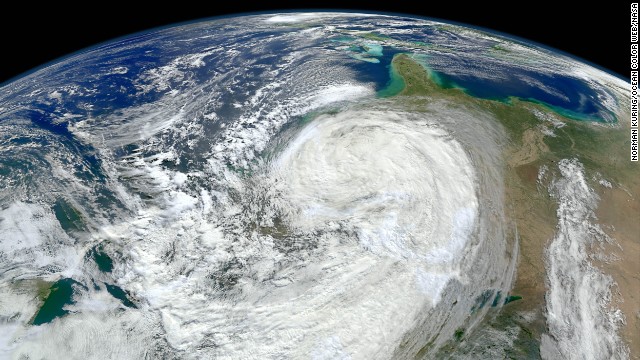 The consequences of climate change go far beyond warming temperatures, which scientists say are melting the polar ice caps and raising sea levels. Meet the team that is measuring climate change in the Arctic on CNN's series. And click through the gallery for a look at 10 other key effects of climate change, some of which may surprise you.
The consequences of climate change go far beyond warming temperatures, which scientists say are melting the polar ice caps and raising sea levels. Meet the team that is measuring climate change in the Arctic on CNN's series. And click through the gallery for a look at 10 other key effects of climate change, some of which may surprise you.  Drought: In the coming decades climate change will unleash megadroughts lasting 10 years or more, according to a new report by scholars at Cornell University, the University of Arizona and the U.S. Geological Survey. We're seeing hints of this already in many arid parts of the world and even in California, which has been rationing water amid record drought. In this 2012 photo, a man places his hand on parched soil in the Greater Upper Nile region of northeastern South Sudan.
Drought: In the coming decades climate change will unleash megadroughts lasting 10 years or more, according to a new report by scholars at Cornell University, the University of Arizona and the U.S. Geological Survey. We're seeing hints of this already in many arid parts of the world and even in California, which has been rationing water amid record drought. In this 2012 photo, a man places his hand on parched soil in the Greater Upper Nile region of northeastern South Sudan.  Wildfires: There's not a direct link between climate change and wildfires, exactly. But many scientists believe the increase in wildfires in the Western United States is partly the result of tinder-dry forests parched by warming temperatures. This photo shows a wildfire as it approaches the shore of Bass Lake, California, in mid-September.
Wildfires: There's not a direct link between climate change and wildfires, exactly. But many scientists believe the increase in wildfires in the Western United States is partly the result of tinder-dry forests parched by warming temperatures. This photo shows a wildfire as it approaches the shore of Bass Lake, California, in mid-September.  Coral reefs: Scientists say the oceans' temperatures have risen by more than 1 degree Fahrenheit over the last century. It doesn't sound like much, but it's been enough to affect the fragile ecosystems of coral reefs, which have been bleaching and dying off in recent decades. This photo shows dead coral off the coast of St. Martin's Island in Bangladesh.
Coral reefs: Scientists say the oceans' temperatures have risen by more than 1 degree Fahrenheit over the last century. It doesn't sound like much, but it's been enough to affect the fragile ecosystems of coral reefs, which have been bleaching and dying off in recent decades. This photo shows dead coral off the coast of St. Martin's Island in Bangladesh.  Food prices: A U.N. panel found in March that climate change -- mostly drought -- is already affecting the global agricultural supply and will likely drive up food prices. Here, in 2010, workers on combines harvest soybeans in northern Brazil. Global food experts have warned that climate change could double grain prices by 2050.
Food prices: A U.N. panel found in March that climate change -- mostly drought -- is already affecting the global agricultural supply and will likely drive up food prices. Here, in 2010, workers on combines harvest soybeans in northern Brazil. Global food experts have warned that climate change could double grain prices by 2050.  Pollen allergies: Are you sneezing more often these days? Climate change may be to blame for that, too. Recent studies show that rising temperatures and carbon dioxide levels promote the growth of weedy plant species that produce allergenic pollen. The worst place in the United States for spring allergies in 2014, according to the Asthma and Allergy Foundation of America? Louisville, Kentucky.
Pollen allergies: Are you sneezing more often these days? Climate change may be to blame for that, too. Recent studies show that rising temperatures and carbon dioxide levels promote the growth of weedy plant species that produce allergenic pollen. The worst place in the United States for spring allergies in 2014, according to the Asthma and Allergy Foundation of America? Louisville, Kentucky.  Deforestation: Climate change has not been kind to the world's forests. Invasive species such as the bark beetle, which thrive in warmer temperatures, have attacked trees across the North American west, from Mexico to the Yukon. University of Colorado researchers have found that some populations of mountain pine beetles now produce two generations per year, dramatically boosting the bugs' threat to lodgepole and ponderosa pines. In this 2009 photo, dead spruces of the Yukon's Alsek River valley attest to the devastation wrought by the beetles.
Deforestation: Climate change has not been kind to the world's forests. Invasive species such as the bark beetle, which thrive in warmer temperatures, have attacked trees across the North American west, from Mexico to the Yukon. University of Colorado researchers have found that some populations of mountain pine beetles now produce two generations per year, dramatically boosting the bugs' threat to lodgepole and ponderosa pines. In this 2009 photo, dead spruces of the Yukon's Alsek River valley attest to the devastation wrought by the beetles.  Mountain glaciers: The snows capping majestic Mount Kilimanjaro, Africa's highest peak, once inspired Ernest Hemingway. Now they're in danger of melting away altogether. Studies suggest that if the mountain's snowcap continues to evaporate at its current rate, it could be gone in 15 years. Here, a Kilimanjaro glacier is viewed from Uhuru Peak in December 2010.
Mountain glaciers: The snows capping majestic Mount Kilimanjaro, Africa's highest peak, once inspired Ernest Hemingway. Now they're in danger of melting away altogether. Studies suggest that if the mountain's snowcap continues to evaporate at its current rate, it could be gone in 15 years. Here, a Kilimanjaro glacier is viewed from Uhuru Peak in December 2010.  Endangered species: Polar bears may be the poster child for climate change's effect on animals. But scientists say climate change is wreaking havoc on many other species -- including birds and reptiles -- that are sensitive to fluctuations in temperatures. One, this golden toad of Costa Rica and other Central American countries, has already gone extinct.
Endangered species: Polar bears may be the poster child for climate change's effect on animals. But scientists say climate change is wreaking havoc on many other species -- including birds and reptiles -- that are sensitive to fluctuations in temperatures. One, this golden toad of Costa Rica and other Central American countries, has already gone extinct.  Animal migration: It's not your imagination: Some animals -- mostly birds -- are migrating earlier and earlier every year because of warming global temperatures. Scholars from the University of East Anglia found that Icelandic black-tailed godwits have advanced their migration by two weeks over the past two decades. Researchers also have found that many species are migrating to higher elevations as temperatures climb.
Animal migration: It's not your imagination: Some animals -- mostly birds -- are migrating earlier and earlier every year because of warming global temperatures. Scholars from the University of East Anglia found that Icelandic black-tailed godwits have advanced their migration by two weeks over the past two decades. Researchers also have found that many species are migrating to higher elevations as temperatures climb.  Extreme weather: The planet could see as many as 20 more hurricanes and tropical storms each year by the end of the century because of climate change, according to a 2013 study published in the Proceedings of the National Academy of Sciences. This image shows Superstorm Sandy bearing down on the New Jersey coast in 2012.
Extreme weather: The planet could see as many as 20 more hurricanes and tropical storms each year by the end of the century because of climate change, according to a 2013 study published in the Proceedings of the National Academy of Sciences. This image shows Superstorm Sandy bearing down on the New Jersey coast in 2012.
- NOAA: Global temperatures pushing record highs this year
- New study finds average global temperatures approaching "dangerous" benchmark
- NOAA data looked at land and ocean conditions, then averaged the numbers
- Parts of Europe, Eastern Russia saw more extreme temperature hike
(CNN) -- The first ten months of 2014 have been the hottest since record keeping began more than 130 years ago, according to data from the National Oceanic and Atmospheric Administration.
That may be hard to believe for people in places like Buffalo, New York, which saw a record early snowfall this year.
But NOAA says, despite the early bitter cold across parts of the United States in recent weeks, it's been a hot year so far for the Earth.
With two months left on the calendar, 2014 is shaping up to be the hottest year on record.
The average global temperature between January and October has been 0.68 degrees Celsius (1.22 degrees Fahrenheit) higher than the 20th century's average global temperature of 14.1 C (57.4 F).
NOAA's analysis is an important "health gauge" indicating an ominous trend for the planet, says CNN meteorologist Derek Van Dam.
"It's becoming increasingly more difficult to be a skeptic of the causes of our warming planet," he says.
Hottest October
This October was the hottest October on record globally, NOAA data showed. The mercury climbed more than one degree Fahrenheit above the 20th century average of 57.1 F.
It was the fourth warmest October on record for the United States, NOAA said.
"The record high October temperature was driven by warmth across the globe over both the land and ocean surfaces and was fairly evenly distributed between the Northern and Southern Hemispheres," the agency said.
That's significant, says Van Dam.
"Most notably, this record warmth is not contained to any specific part of the world. Meaning, we are all in this together," he says. "So far this year, record-breaking warmth has been observed in at least every continent and major ocean basin of our planet. This is something we cannot ignore."
Important benchmark
NOAA's analysis breaks down global temperatures into two categories -- land and ocean -- then an average that includes both. The record high temperatures in October were recorded across both land and sea.
The surface temperature on land approached an important scientific benchmark. It was almost 2 degrees Celsius higher than the 20th century average for October of 9.3 C (48.7 F).
Scientists have long predicted that a change in global average temperature of just 2 to 3 degrees higher could spell disaster for the planet, contributing to catastrophic storms, sea level rise, dangerous storm surges and melting polar ice.
According to the non-binding international agreement on climate change -- the Copenhagen Accord, reached in 2009 -- any temperature increase above the 2 degree Celsius mark is "dangerous."
NOAA said the ocean temperatures were also the warmest on record in October with an increase of 1.12 F over the 20th century average of 60.6 degrees.
Hot spots
"Record warmth for the year-to-date was particularly notable across much of northern and western Europe, parts of Far East Russia, and large areas of the northeastern and western equatorial Pacific Ocean, " NOAA said. "It is also notable that record warmth was observed in at least some areas of every continent and major ocean basin around the world," the agency added.
Of particular note, several countries have already seen an average temperature increase of more than 2 degrees Celsius in October 2014 compared to 20th century averages, including Australia, Germany, France, Switzerland, and Sweden.
There was also one notable cold spot on the map.
The average temperature this year in the midsection of the United States, which saw a severe winter, has been below the 20th century average.